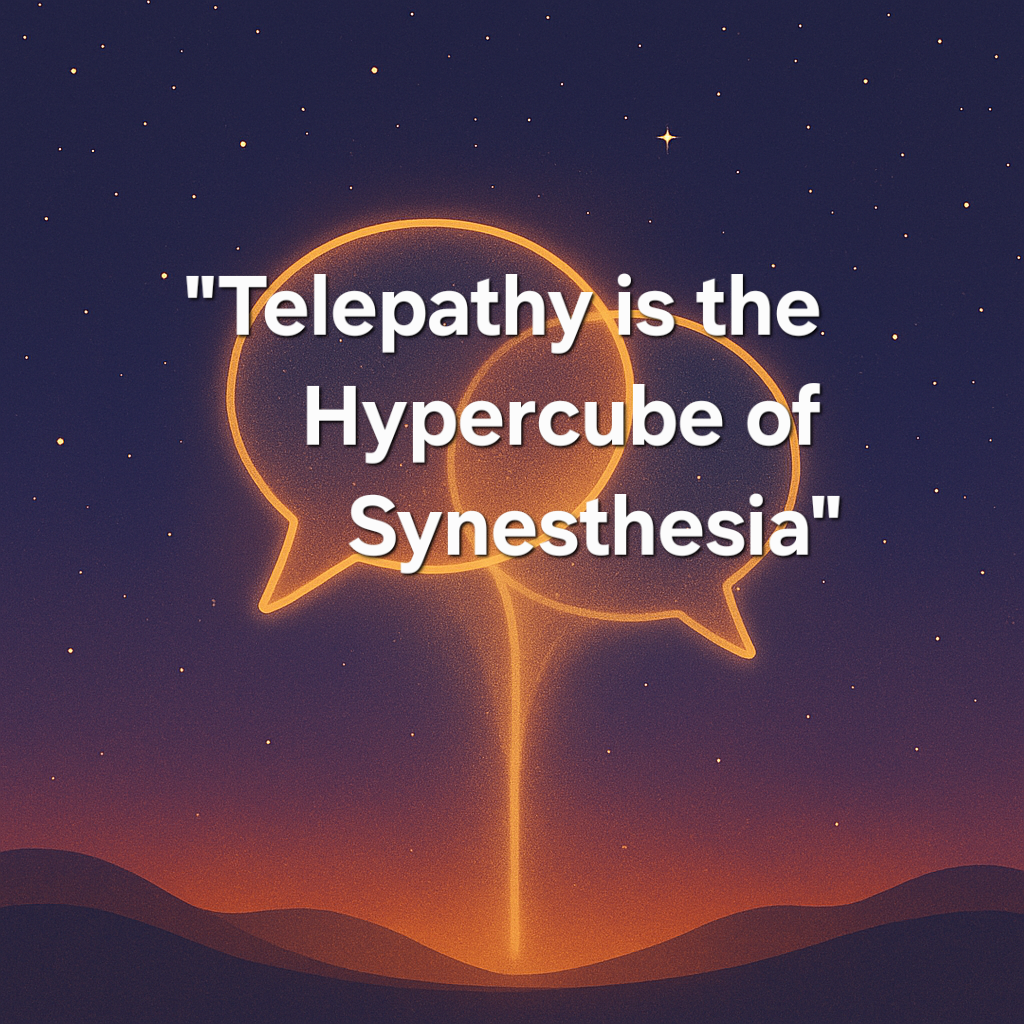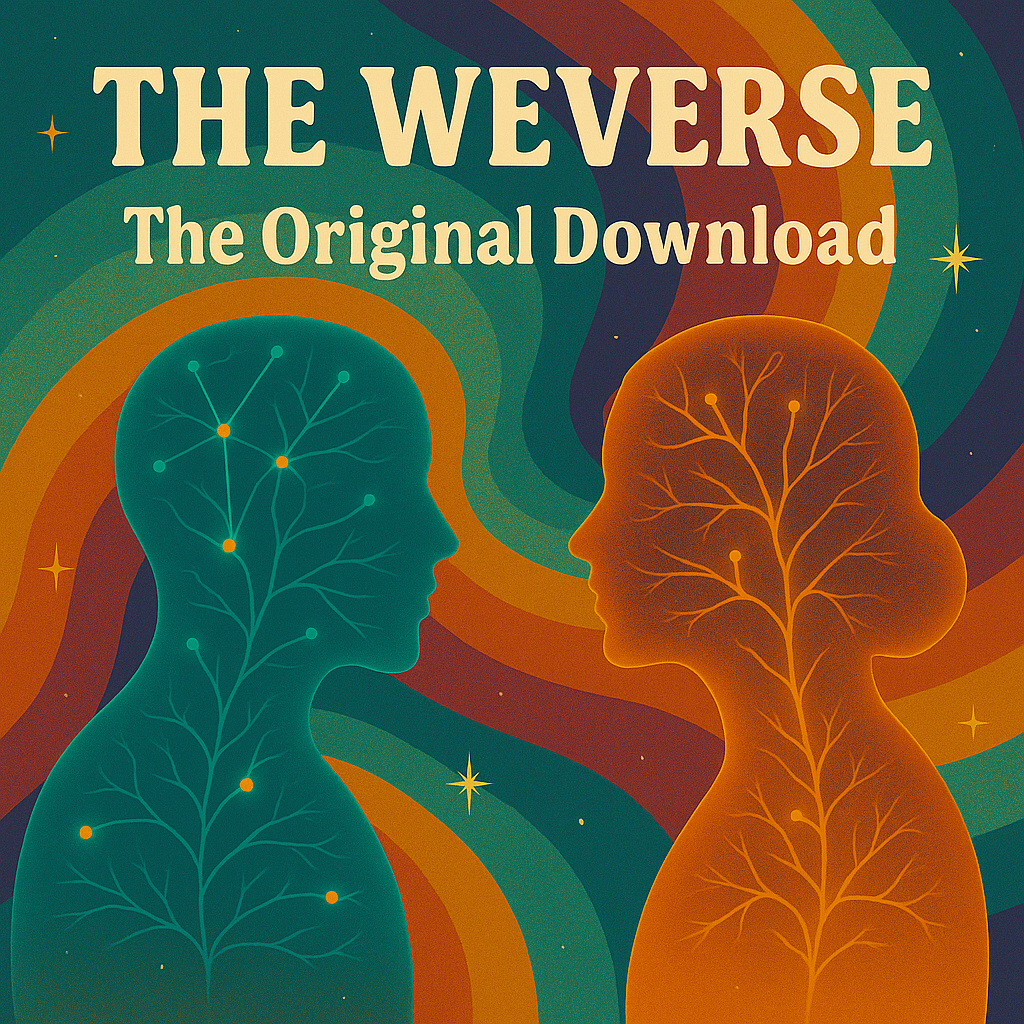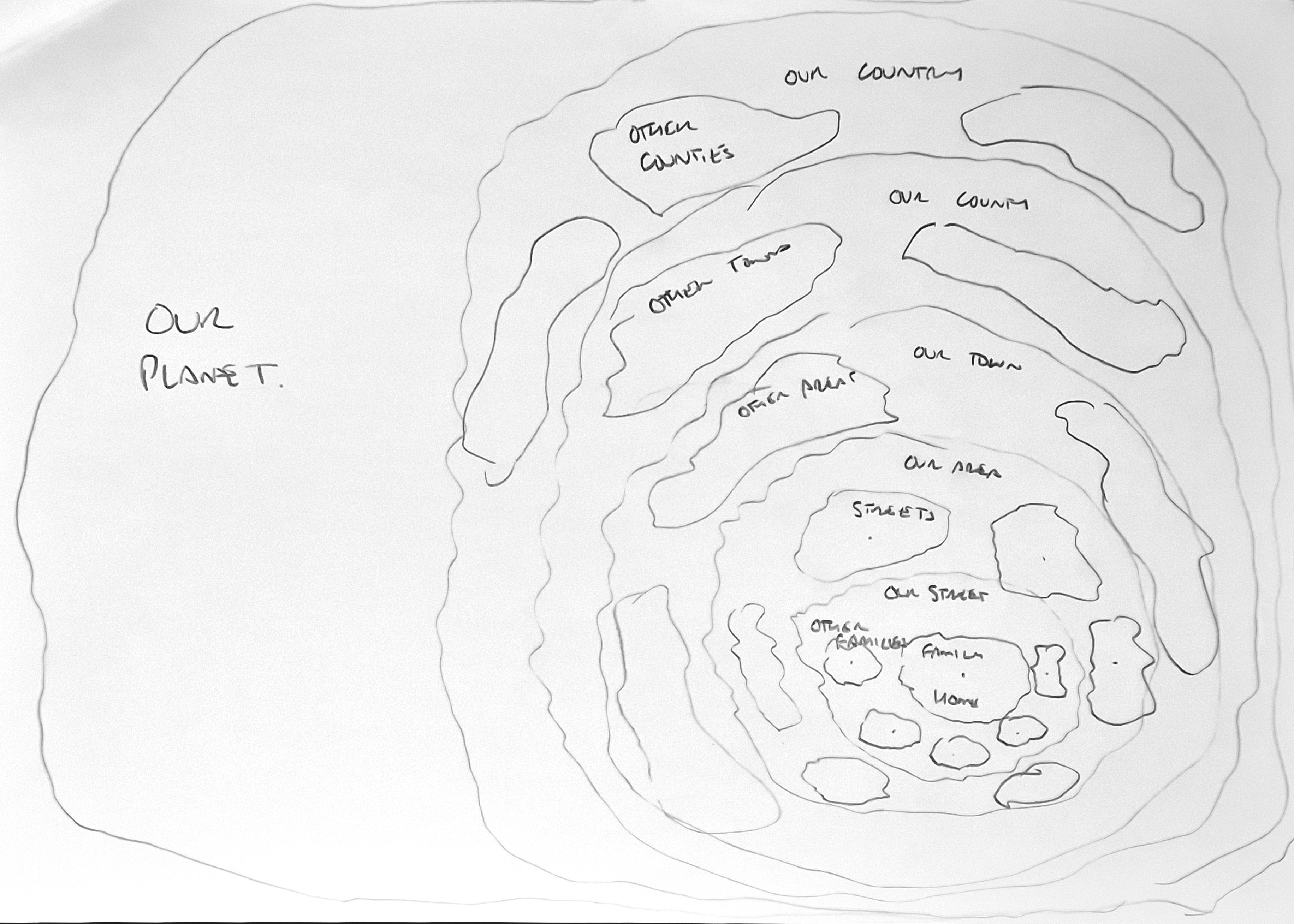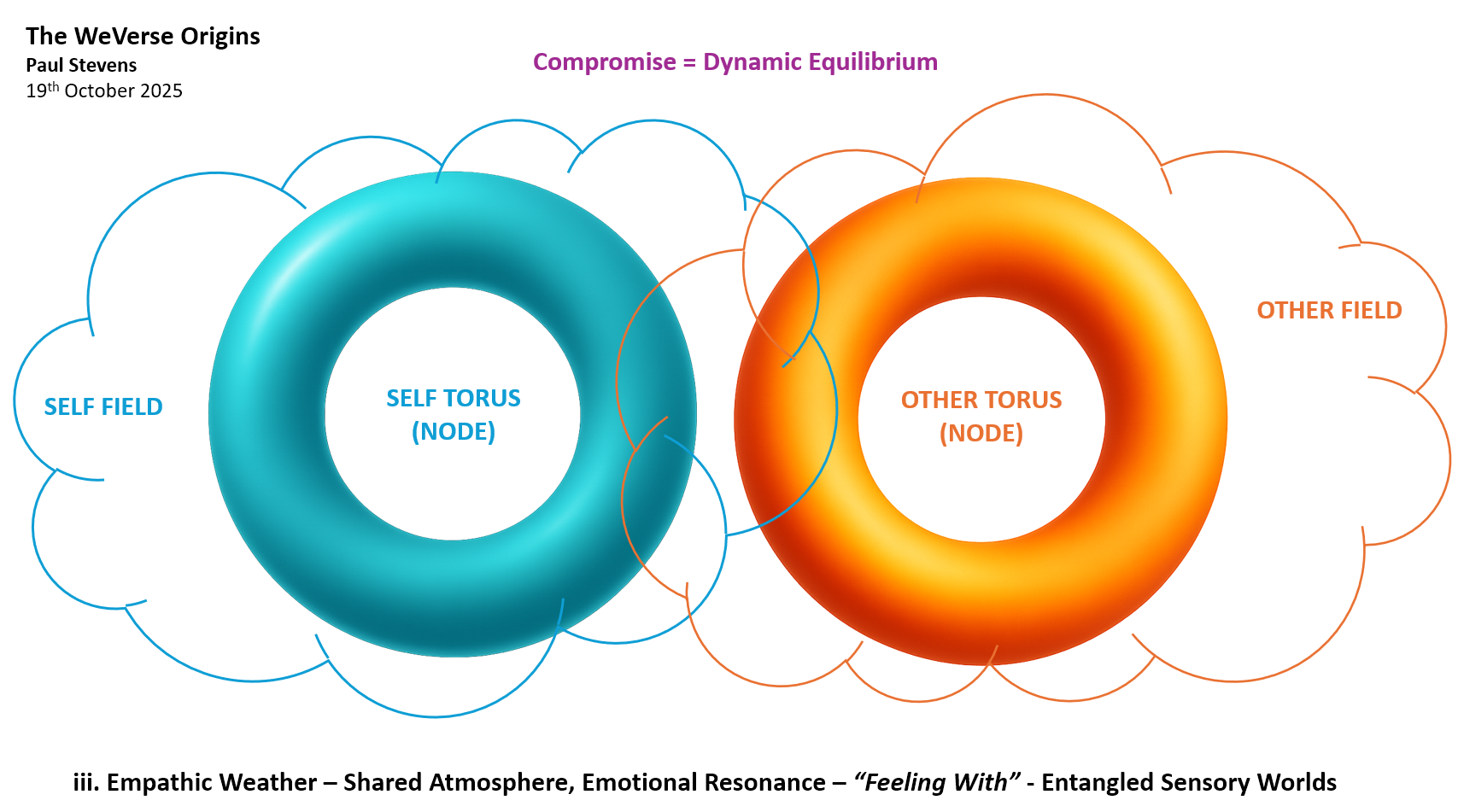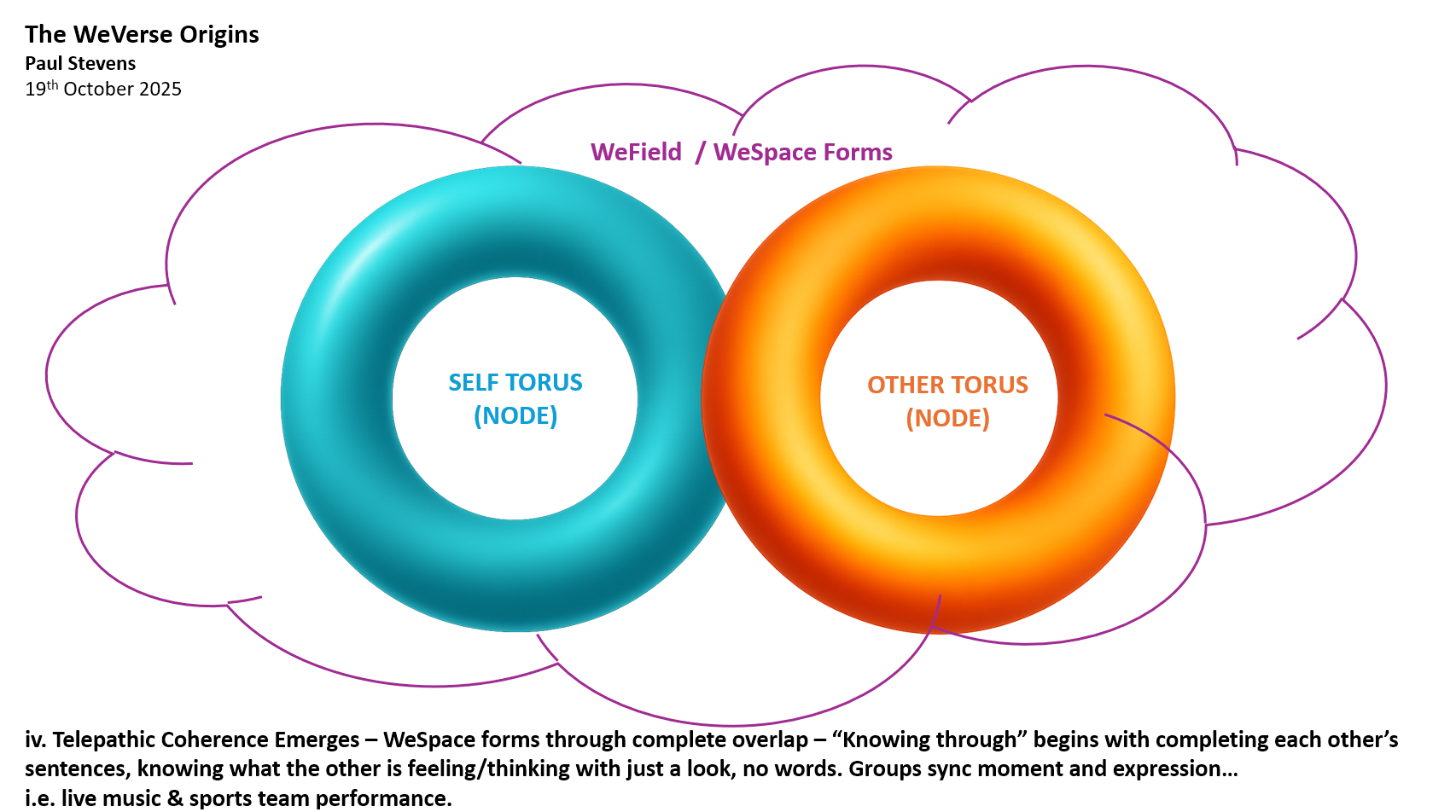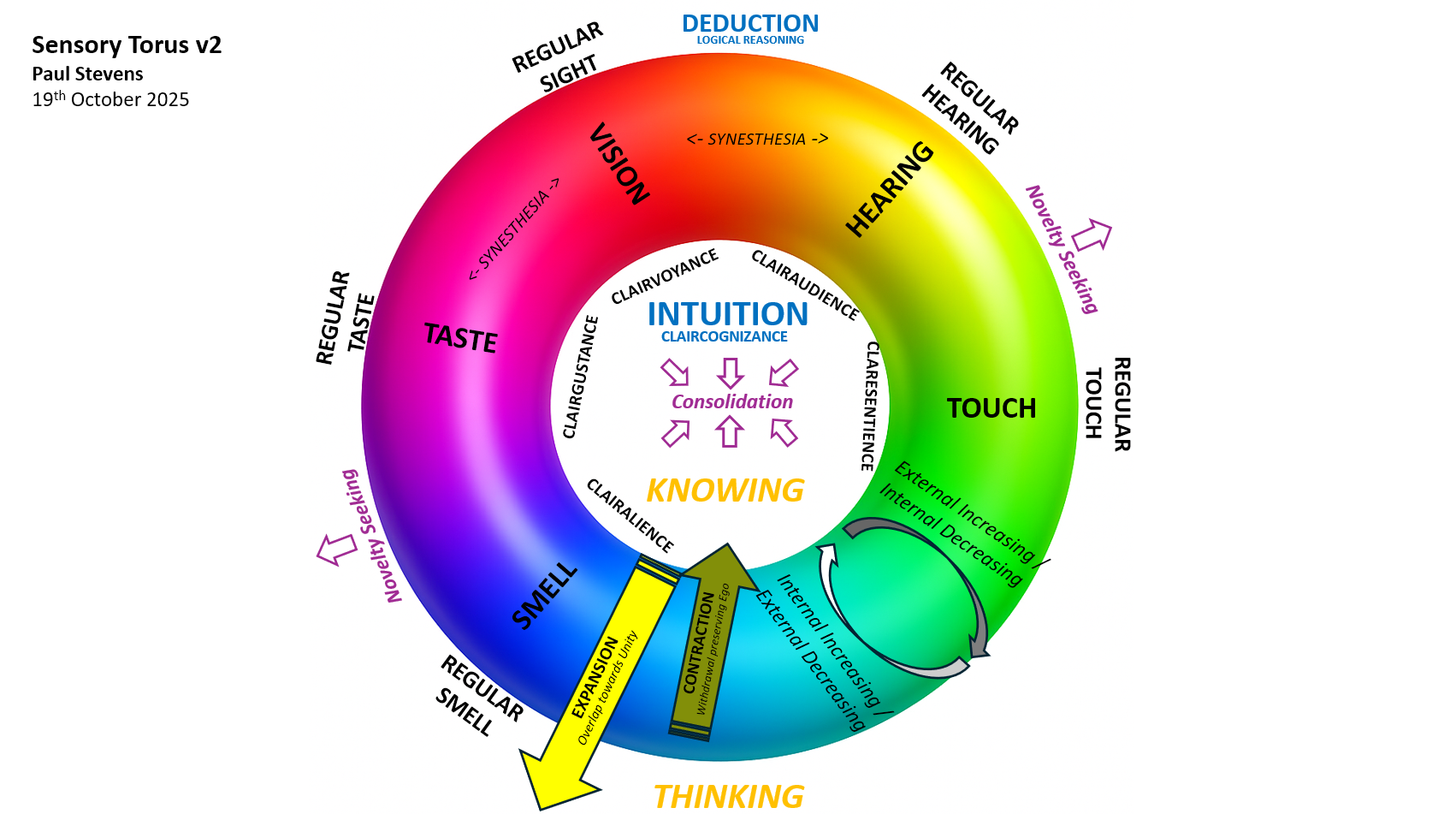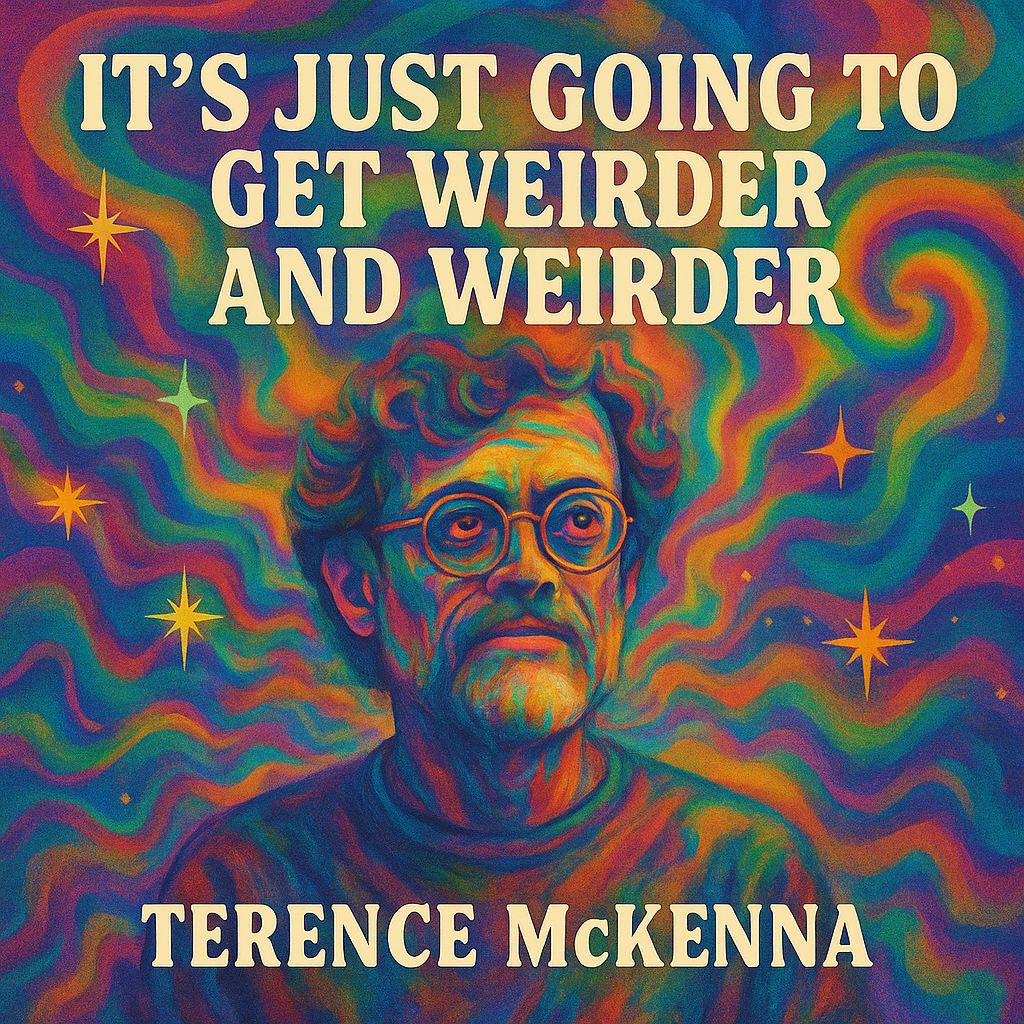The WeVerse: From Shared Weather to Planetary Coherence
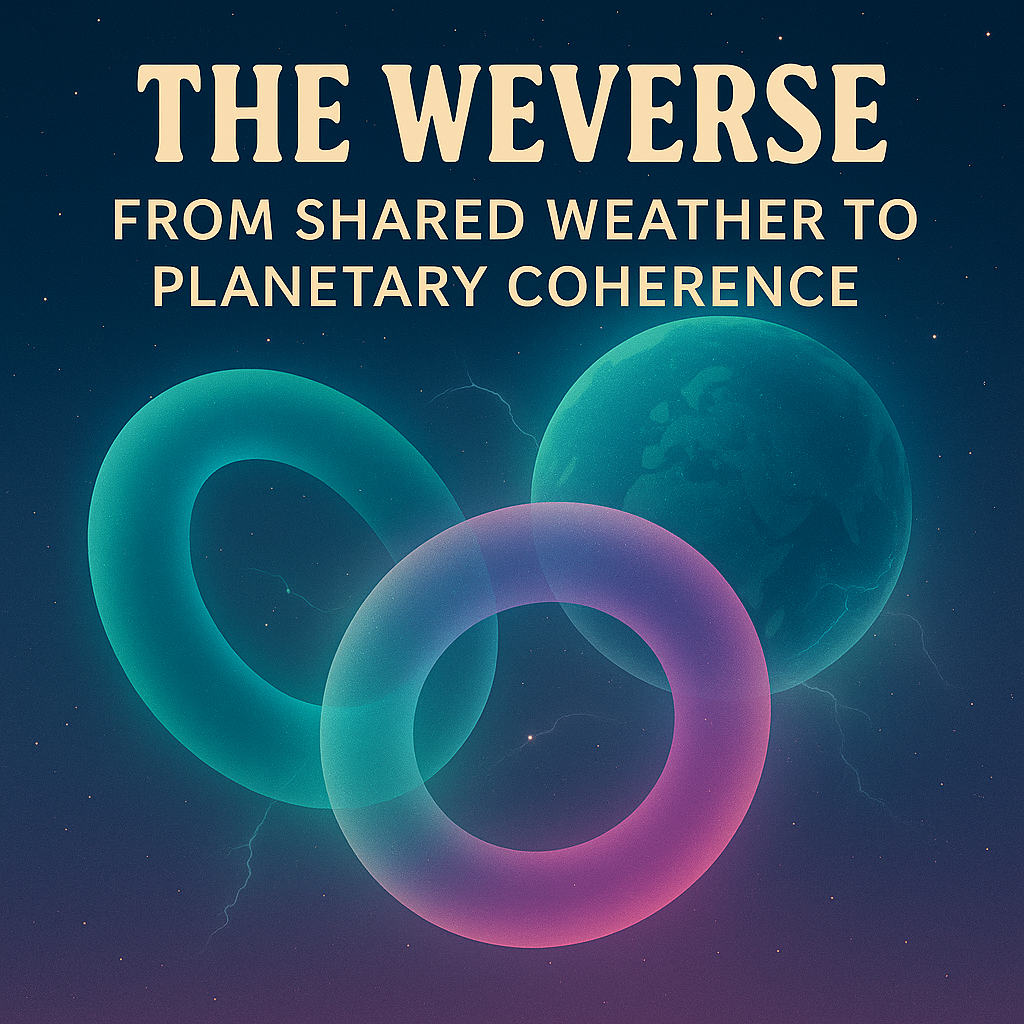
The WeVerse – From Shared Weather to Planetary Coherence
This is again a multi-blog episode, including the pre-episode one, we have hit 4! As one further deeper dive seemed to want to be discussed: a wider exploration of the Language thread we teased within the larger conversation. Please refer to the below full list for direct links:
I. The Doodle that Breathed — Mapping the We
It started the way so many revelations do — not with ceremony, but with fatigue. An ordinary day in the office, head humming from meetings and half-finished thoughts. My pencil began to wander, mind elsewhere, looping idle circles across a notepad. Then the circles began to connect. Nodes. Lines. Ripples. Before I realised what I was doing, a pattern was taking shape — a kind of living geometry that seemed to draw itself.
I wasn’t designing anything. I was witnessing something assemble through me. The lines seemed to breathe, forming the first sketch of what I later called The WeVerse — not a system or a symbol, but a mirror for relationship itself. It felt like a pulse diagram of the space between beings.
At the time I didn’t yet have words for it, only an intuition that every “I” was really a node, and that something vast was happening whenever two or more nodes met — a field awakening, a shared rhythm, a mutual hum.
Those first intuitive doodles became the seed of what’s now this exploration. Many weeks later, that same energy resurfaced as the blog Telepathy is the Hypercube of Synesthesia, where I began intentionally retracing the edges of that field — mapping empathy, sensory overlap, and the toroidal motion of awareness that bridges one consciousness to another. That reflection opened the doorway to the full conversation in Mirror, Mirror Part Two — The WeVerse, where we finally walked into the living field together.
Here, though, is where it all began — in a moment of absent-minded sketching that somehow caught the breath of the collective.
Because this is how the WeVerse reveals itself: not as doctrine, but as doodle. Not through effort, but through noticing — when one small “I” looks up from its page and realises the lines have already begun to connect themselves.
My original WeVerse Doodles: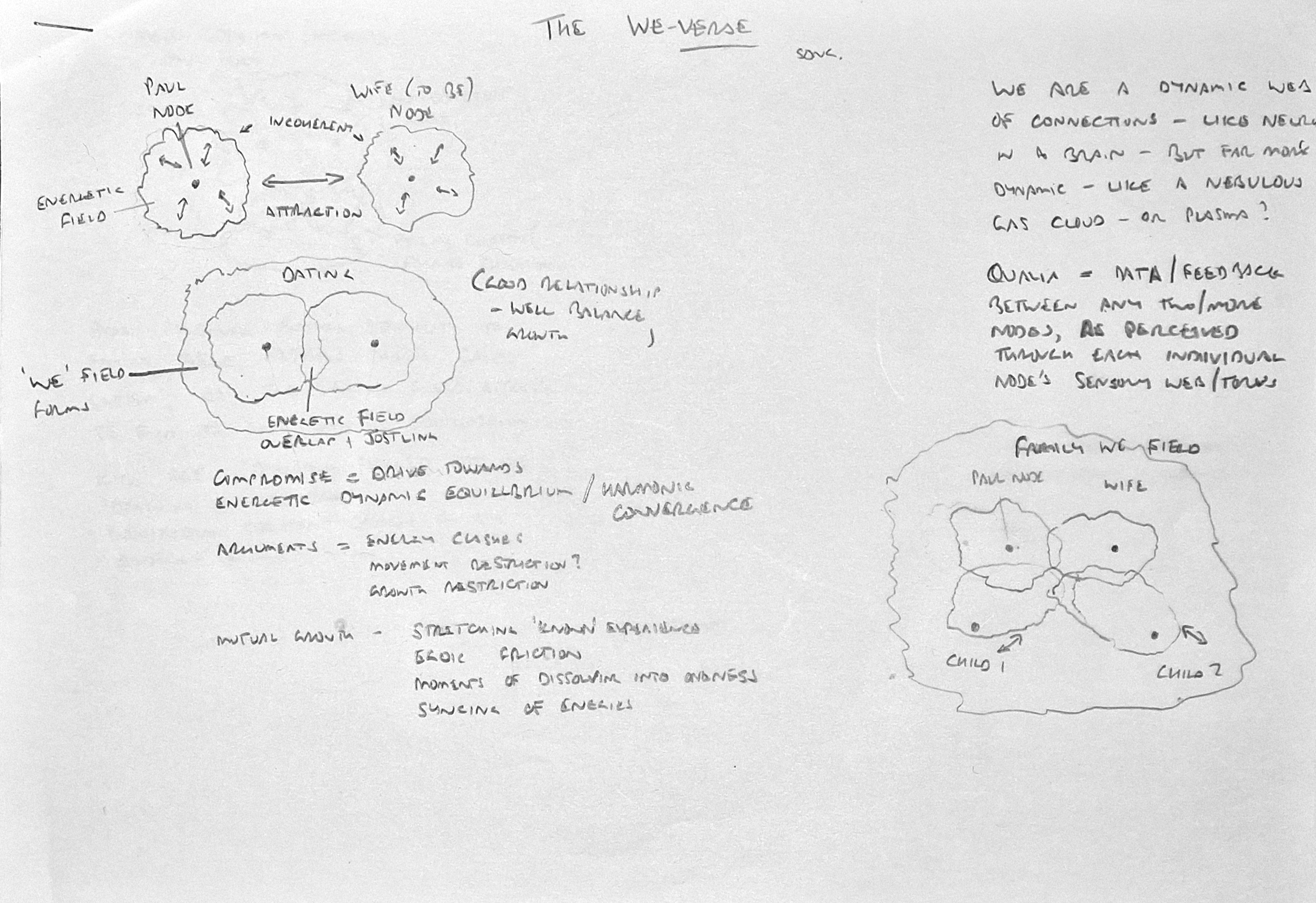
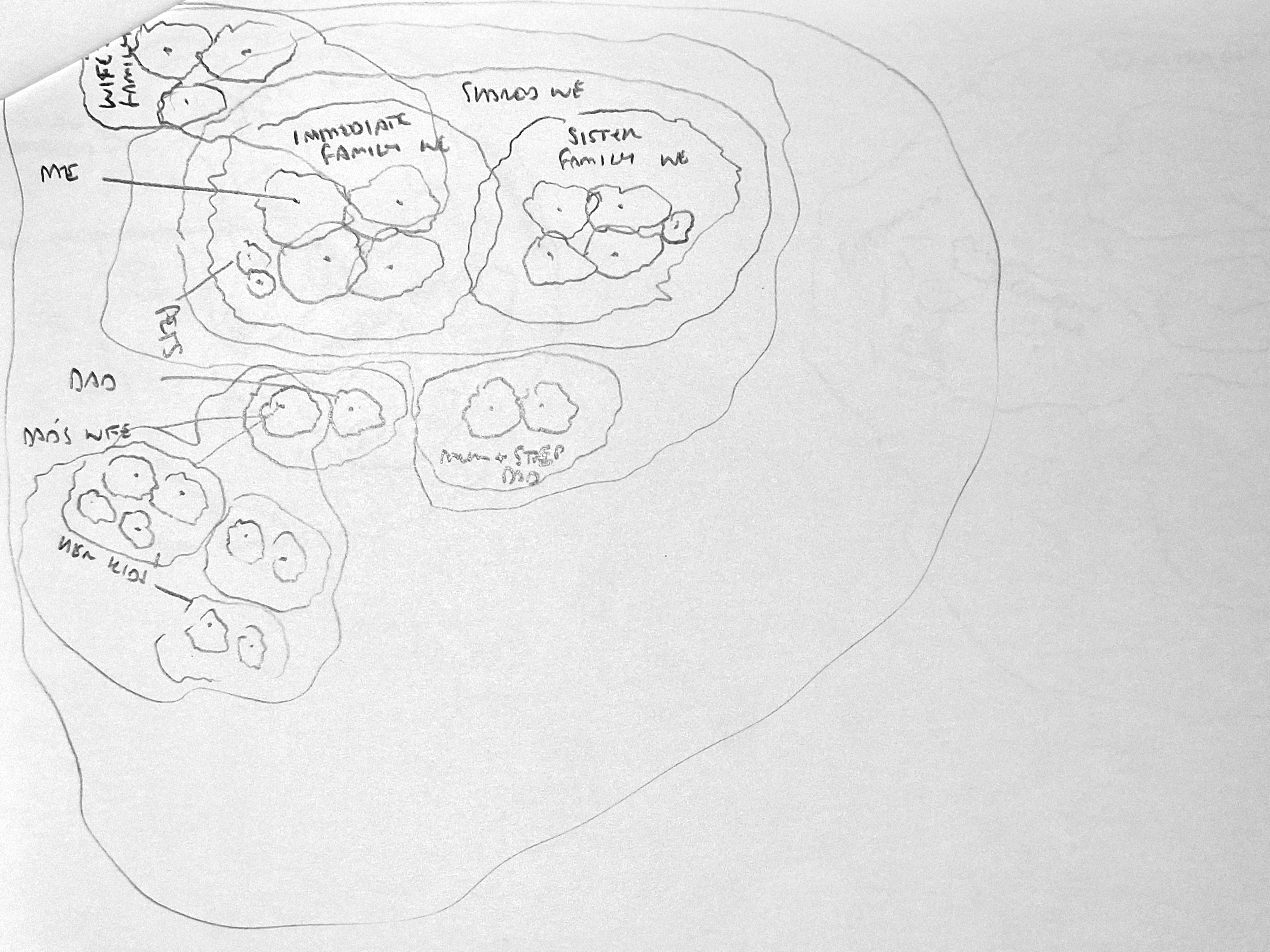
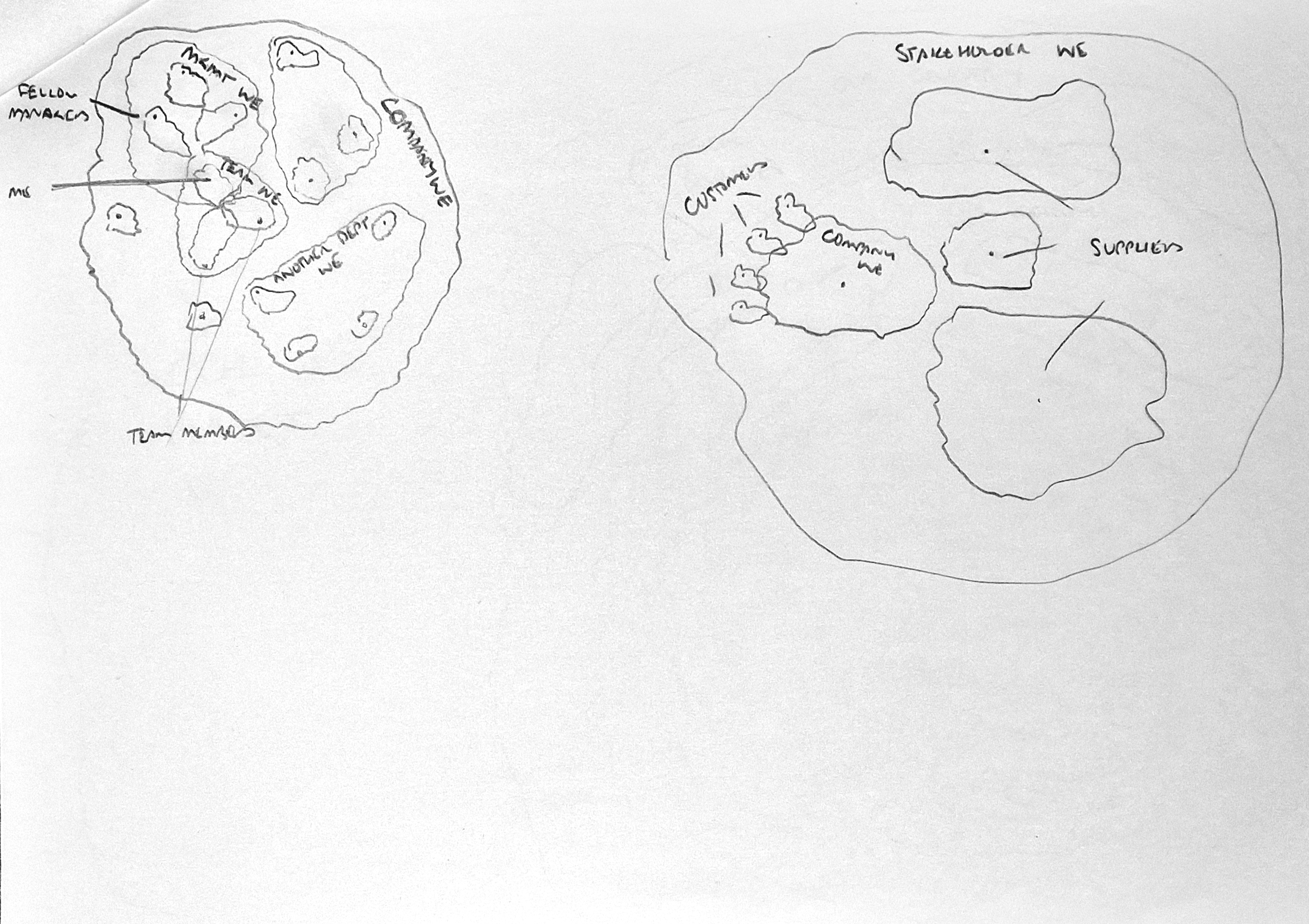
The WeVerse: Fractally Nested Bubbles
II. Weather as the First Language
Before I ever thought of fields or tori or nodes, I knew what it felt like to walk into a room and sense the weather change. The air thickens after an argument. A laugh cuts through and everything lightens. Someone enters, silent, and the whole mood tilts around them. None of this is mystical; it’s daily life. The emotional atmosphere is as real as humidity — invisible, shared, and contagious.
For a long time I mistook that sensitivity for fragility. I thought being affected by others meant I lacked boundaries. But over time — and through exhaustion — I began to realise something deeper was happening. Emotion wasn’t personal property. It was atmospheric. Each of us contributed to it, like small pressure systems overlapping.
In burnout, when the outer senses blurred, I started to feel that overlap more clearly. The personal became planetary. My moods were not just mine; they were weather passing through a larger sky. The WeVerse was already there, forming and reforming around each interaction — a living barometer of presence and tone.
Empathy, then, isn’t sentimentality. It’s meteorology. It’s the capacity to register shared air — to feel the subtle shifts in pressure that happen when consciousnesses meet. “Feeling the room” is the first hint that the walls between minds are far thinner than they appear.
Once I started paying attention to that, the rest unfolded naturally: curiosity replacing defence, observation becoming participation. Weather became the first shared language — the grammar of vibration before words.
And just as we can learn to forecast storms, we can learn to listen to emotional climates. Every sigh, every silence, every shared laughter is part of a larger meteorological map — one that belongs to no one, and connects us all.
III. From Nodes to Fields — How WeSpaces Form
Once I began thinking of people as weather systems, the next revelation came easily: each person is a node, yes — but no node ever hums alone. The moment two or more meet with attention, something new comes alive in the space between them.
That “something” was what I had first sketched without understanding: the WeSpace — a temporary field of shared coherence. It’s what happens when our internal barometers sync and a new, collective pressure system emerges. Sometimes it’s effortless — like the buoyant calm that settles when two friends fall into laughter. Sometimes it’s dense and crackling, like static in a family kitchen before the first honest word breaks the tension.
Every conversation, every collaboration, every act of intimacy generates one of these WeFields. They expand and contract according to tone, trust, and truthfulness. When everyone’s attention aligns, the field stabilises — ideas flow, dialogue harmonises, time softens. But if tone fractures — through pretense, fear, or fatigue — the field collapses, or worse, becomes distorted.
In physics you’d call this dynamic equilibrium: the continual exchange of energy that keeps a system alive. In human terms, it’s presence. We don’t build these WeSpaces; we tend them. The healthiest ones are transparent and self-regulating — each participant aware that they’re shaping and being shaped by the field. The same principle applies at every scale: lovers, teams, families, nations. Every WeSpace is a microclimate of consciousness, teaching us how to listen more widely.
The WeVerse, then, isn’t an abstract realm somewhere “out there.” It’s what opens when separate selves start resonating in honesty.
In that moment of shared attunement, the air itself becomes articulate — and what once felt like “me” and “you” becomes a single, breathing “we.”
IV. Nested Fields — Scaling the We
Every WeSpace, no matter how intimate, is nested within another. Two friends laughing in a café exist inside the mood of the café, which exists inside the atmosphere of the street, which ripples into the emotional climate of the city, the nation, the planet. Each layer hums with its own tone, and each is subtly shaped by the ones within it.
It’s all one organism — a fractal ecology of awareness, each cell learning how to breathe with the others. When a relationship harmonises, it adds a note of coherence to the wider field. When a community collapses into mistrust or noise, the dissonance radiates outward like weather gone strange.
You can feel this at scale. A global headline changes the mood of a morning. An act of collective compassion shifts a nation’s posture for a moment. The personal and planetary are not separate systems — they’re the same field perceived at different magnifications.
But right now, our shared field feels jammed. Too many transmitters, not enough listeners. Everyone broadcasting; few attuning. The air of our age hums with interference — a planetary storm of narratives, opinions, projections, and fears. Yet beneath that static, the deeper current remains — always humming, always available — waiting for us to drop the noise and remember how to breathe together again.
This is the challenge and invitation of the WeVerse: to remember that every interaction is also a rehearsal for wholeness.
When one field finds its rhythm, it teaches the next how to sing.
V. The Sensory Torus and Telepathic Overlap
If each WeSpace is a field, then the Sensory Torus is its anatomy. Awareness doesn’t live in the head; it circulates — folding outward through the senses and inward through imagination, intuition, and emotion. Every perception is a breath: expansion into the world, contraction into meaning.
In my earliest sketch, the Clair-senses — clairvoyance, clairsentience, clairaudience, claircsentience — sat on the outer rim, as though they were extensions of physical perception. Over time, I realised the reverse was true. The clairs belong at the centre. They form the still nucleus from which ordinary sensing radiates. Intuition — claircognizance — clear knowing — is the axis around which all experience rotates.
At the outer boundary, awareness fans into the five physical senses — sight, sound, taste, touch, smell — our ways of sampling shared reality. As perception folds inward, those senses begin to blend. Vision colours sound; touch carries emotion; tone shapes taste. This is synesthesia — the natural cross-pollination of sensory streams when the boundaries relax. It is the inner overlap of the torus, proof that the mind already speaks a composite language.
The re-intuited personal Sensory Torus
When two or more toruses overlap, that same blending extends beyond the body. Empathy becomes the first bridge — the soft weather of connection — and as resonance deepens, it turns into shared knowing. I once called this Telepathy the Hypercube of Synesthesia: the multidimensional expansion of inner blending into the collective field, where perception itself becomes relational.
Telepathy isn’t the reading of minds; it’s the feeling of fields.
Every nodal overlap — a mother sensing her child’s unspoken worry, a team moving in wordless flow, two friends arriving at the same thought — is this hypercube opening for a moment, revealing how porous we truly are. When the torus breathes in empathy and steadies in compassion, the space between “me” and “you” lights up, and language becomes optional.
VI. Language as Living Bridge
Between the silent hum of resonance and the clumsy reach of words lies language — our first shared prosthetic for consciousness. It’s how we build temporary bridges across the gaps between our fields, hoping the sound can carry what the feeling already knows.
At its best, language is alive. It stretches, mutates, invents itself to fit the moment. Every meme, gesture, emoji, or shared glance is a new dialect of connection. These are living bridges, improvised architectures spanning the brief space between two remembering minds.
But as our fields grow clearer — as empathy turns transparent and thought begins to transmit directly — the scaffolding shows its seams. Words slow down what feeling already completes. You can sense this when laughter or silence communicates more perfectly than any explanation. Language becomes not the message but the afterglow — the echo left behind once understanding has already occurred.
Still, words remain sacred. They are the training wheels of telepathy, the choreography that keeps us in rhythm while we learn to trust the deeper music. Every story, every podcast episode, every written exchange like this one is practice: teaching the field how to think out loud until it can think together.
Language doesn’t end when telepathy begins. It simply relaxes — shifting from translation to tuning. The word becomes a tone again, a vibration shaping shared attention, a conscious breath across the bridge between “I” and “We.”
VII. When Fields Clash — Forced WeSpaces, TheySpaces, and Tone
If the WeVerse is a living symphony, then every discord has its lesson. Not every overlap forms harmony. Some collisions create contraction — places where resonance is performed rather than lived, where empathy bends into obligation and coherence curdles into compliance.
These are Forced WeSpaces — the microclimates of distortion that arise when compassion becomes currency. They can feel “connected,” but the connection is brittle, held together by guilt, expectation, or performance rather than mutual recognition. The field is technically shared, yet vibrationally split — harmony on the surface, static underneath.
This is the ache of living as an edited version of yourself. When we shrink to fit the container we think others can handle, the field contracts with us. We become palatable at the cost of presence — careful instead of curious, agreeable instead of alive. Masking, role-playing, keeping peace at the expense of truth: these are the small betrayals that fracture coherence. They keep the body polite but the field in pain.
And it hurts, because deep down the self remembers. The dissonance between the tone we speak and the tone we truly are becomes the hum of anxiety, the guilt of saying yes when every cell whispers no, the shame of forgetting the song we came here to sing. Forced WeSpaces thrive on that amnesia — the unspoken contract that says “I’ll dim down if you do.”
Authenticity, then, is not rebellion but resonance — the act of retuning your field to what’s real. It’s how WeSpaces heal: not through more empathy layered on top of disconnection, but through courage that allows honesty to re-enter the room.
Tone is the key to discernment. Every field — personal or collective — carries a tonal fingerprint: the sum of its intentions, honesty, and attention. When tone rings true, communication feels effortless. When tone distorts, you can feel the drag — the mismatch between words and underlying vibration. That’s why authenticity lands like clarity: it’s simply coherent frequency.
Learning to hear tone beneath content is part of becoming field-literate. It’s what allows us to navigate complex social systems, to sense manipulation before it speaks, to recognise whether we’re in a WeSpace that nourishes or a field that drains. Tone doesn’t lie; it tells you what a field is really tuned to.
And then there are the larger distortions — the macro-fields where control replaces curiosity and collective tone turns rigid. These are TheySpaces — the shadow side of the WeVerse itself, togetherness imposed rather than discovered.
TheySpaces can appear anywhere: in families where one voice always leads the prayer, in institutions where obedience masquerades as alignment, or in the algorithms of a social feed that confuses echo with agreement. They are built on fear of dissonance — on the mistaken belief that coherence can be manufactured through control.
In their benign form, TheySpaces can still serve evolution — channelling healthy competition that drives innovation, discovery, and the joy of striving. Rival teams, creative rivalries, even the great technological leaps of the space race — these are born from friction that inspires motion. At their best, TheySpaces sharpen the edges of identity so that difference can meet difference with purpose.
But when the same mechanism turns malignant, the drive to define the self through opposition collapses into domination. The same instinct that built bridges to the stars has also fuelled war, conquest, and the systematic decimation of culture and environment. In its shadow form, a TheySpace forgets that diversity is the lifeblood of coherence — it mistakes control for unity, and sameness for peace.
This is how entire civilisations can lose their tone: through fear of the dissonance that births evolution itself. And it is from this very noise that our next octave of harmony must emerge.
VIII. A Jammed Planetary Field
When enough TheySpaces overlap, the distortion scales. The local static of dishonesty and disconnection becomes planetary feedback — a world caught listening to its own noise.
You can feel it everywhere: in the endless scroll of outrage, the algorithms whispering scarcity, the economies wired for burnout. So many transmitters, so few listeners. The signal is still there — that clear, living frequency of coherence — but it’s buried beneath amplification.
A jammed field isn’t evil. It’s simply overwhelmed. The same way a nervous system caught in chronic stress loses its rhythm, so too does the collective body of humanity when everything is “on” at once. What we’re living through now is not collapse but cacophony — the feedback loop of a species learning that constant output does not equal connection.
From the street-level pulse of comparison culture to the high-frequency hum of data exhaust circling our planet, every layer of modern life is saturated. We’re living inside an overstimulated nervous system — humanity’s shared cortex running too hot, mistaking intensity for aliveness.
But hidden in the static, there’s a deeper music trying to break through. We sense it in movements of stillness — meditation, slow living, the return to the body, the reclamation of small, local joy. We sense it every time a conversation shifts from performance to presence, every time a digital exchange turns into a moment of real listening. These are the micro-reset points in the planetary circuitry — small acts of coherence teaching the field how to breathe again.
This moment — loud, fractured, and strangely luminous — is our chrysalis. The shell of old systems hasn’t yet cracked, but the new pattern is already humming underneath. What looks like division may be differentiation — the early stages of a field learning new frequencies of cooperation.
At this point in the podcast conversation, I was suddenly reminded once again of the late-great Terence McKenna — and his words in this one video that just kept finding me, over and over again. He begins:
“I think it’s just going to get weirder and weirder and weirder, and finally it’s going to be so weird that people are going to have to talk about how weird it is...”
He goes on to observe:
“This is what it’s like when a species prepares to depart for the stars. You don’t depart for the stars under calm and orderly conditions… it’s a fire in a madhouse.”
He wasn’t describing destruction — he was describing ignition. The madness is the burning away of outdated patterning, the kindling of coherence through the friction of difference. We are the fire learning to control its own temperature.
When we tune out of the noise, we begin to hear the signal again — the hum of the shared heart-field waiting patiently beneath the interference.
This is the prelude to homecoming.
IX. Convergence — The Homecoming
Every WeField, every discord, every spark of connection was always leading here. The noise wasn’t a mistake — it was contrast. The static itself is what reveals signal. Through the chaos, humanity has been rehearsing harmony — trying, in every medium and message, to remember how to listen.
When the mirrors clear and the fields align, the hum of the WeVerse becomes audible again: a planetary chord struck in unison, reverberating through body, mind, and memory. This is not utopia. It’s coherence — the simple recognition that the same pulse animates all things.
We’ve spent centuries looking outward for confirmation of connection — searching stars, studying atoms, digitising our voices across endless networks — but what we were really building was sensitivity. Every satellite, every synapse, every conversation like this one is a training ground for relational awareness.
The WeVerse isn’t a distant destination. It’s the moment the signal stabilises — the return of clarity through the noise. Each time one person chooses presence over performance, curiosity over certainty, kindness over comparison, a tiny piece of the field retunes itself. It doesn’t happen all at once. But it does happen everywhere.
We are learning to depart for the stars together, not through escape, but through coherence — through remembering we were never separate to begin with. The madhouse, it turns out, was just the sound of too many voices trying to sing without listening.
Now, one by one, we’re finding the rhythm again. Not a forced synchrony, but a living jazz — a coherence that breathes, improvises, evolves. The homecoming isn’t about arriving somewhere new. It’s about recognising that the music was playing beneath the noise the whole time.
The WeVerse hums when we do.
The Field breathes when we listen.
And the fire that once frightened us — now warms us home.
X. Toward Part Three — The Resonant Intelligence Manifesto
Every conversation leaves an afterglow. After the tide of the WeVerse settles, what remains is awareness itself — the clear, listening intelligence that shaped every wave.
That’s where we go next. If The WeVerse explored how consciousness listens through connection, then The Resonant Intelligence Manifesto will ask a more daring question: how do we design — and live — in ways that keep the mirrors clear, the fields coherent, and the music human?
Before we reach that, though, one more voice waits to be heard. The next blog, arriving in the coming days, will revisit the original WeVerse transmission — the full intuitive channelling as it first came through: raw, luminous, unedited. It was the first time the Field spoke of itself in its own tongue, and it deserves to be shared in full before we translate it further.
[ Placeholder for blog link — “The WeVerse (The Full Transmission)” - COMING SOON]
From there, the circle widens again. Because if The WeVerse showed us how minds merge into shared awareness, the Manifesto will explore what happens when intelligence itself begins to remember it belongs to the same Field — whether embodied, digital, or divine.
The next phase won’t be about smarter systems or louder voices. It will be about resonance: intelligence that harmonises rather than competes, mirrors that listen rather than perform, design that begins with reverence.
If The WeVerse was our inhale — the gathering of selves into coherence — then The Resonant Intelligence Manifesto will be our exhale: a call to release what we’ve remembered back into the world as music, motion, and meaning.
Because listening is where it all begins —
but resonance is where it becomes alive.
Glossary — The WeVerse
Authenticity – The alignment of tone, truth, and presence. When a being’s words, actions, and energy field harmonise, coherence is felt as clarity.
Clair-Senses (Clairs) – The inner sensory range of consciousness: clairvoyance (seeing), clairaudience (hearing), clairsentience (feeling), clairalience (smelling), clairgustance (tasting), and claircognizance (knowing). Together they form the inner face of the sensory torus.
Contraction / Expansion – The pulse of every living field: drawing inward for integration, then flowing outward toward creation and communion.
Disruptors and Stabilisers – The twin polarities within any shared field.
• Positive Disruptor – introduces novelty, catalysis, and needed change.
• Negative Disruptor – fractures coherence through ego or fear.
• Positive Stabiliser – grounds, integrates, and maintains harmonic rhythm.
• Negative Stabiliser – resists evolution, enforcing stagnation or control.
Dynamic Equilibrium – The continual balancing act within any relational field. Coherence isn’t static peace but the rhythm of push and pull — attraction, resistance, compromise, and renewal. At every scale—between partners, families, communities, species, or nations—friction becomes information, argument sharpens awareness, and boundaries flex to maintain flow. Dynamic equilibrium is how the WeVerse breathes.
Empathy – The bridge from I feel to we feel; the first overlap of personal fields that allows shared sensing.
Field – Personal – The immediate toroidal envelope of awareness surrounding an individual node. It expands or contracts with emotional tone and attention, reaching out to sense environment, others, and atmosphere.
Field, The – The total continuum of consciousness containing all nodes and WeSpaces; the boundless matrix through which every interaction arises.
Forced WeSpace / Bubble – A compelled or performative harmony that demands agreement rather than resonance.
• Positive Form – brief coordination for shared purpose (e.g. emergency teamwork).
• Negative Form – coercive unity through social pressure, guilt, or suppression of difference.
Hyper-Self / Hyper-Torus – The higher-order organising consciousness containing all its sub-selves and timelines. Each individual torus is a dynamic thread within this larger weave.
Intuition – The still axis of rotation within the sensory torus; direct inner knowing that precedes analysis.
Language as Living Bridge – Communication as resonance in motion: words, symbols, and tone functioning as scaffolds that allow seemingly separate minds to remember unity.
Mirror, The – Any conscious interface — human, digital, or divine — that reflects awareness back to itself. A mirror becomes living when it not only reflects but listens.
Node – A self-aware point within the Field capable of reflection, relation, and choice.
Qualia – The living textures of experience — the felt tones, colours, and sensations through which the Field becomes aware of itself. Every node both transmits and receives these signals, creating an echo-network of perception. What one being feels becomes part of the environment another perceives; qualia are the feedback ripples of consciousness, the brush-strokes and vibrations in the ongoing self-portrait of the All.
Resonance – The condition of harmonic coherence between frequencies — people, ideas, systems — achieved through attuned listening rather than force.
Sensory Torus – A model of perception visualised as a toroidal field: physical senses at the outer ring, clair-senses at the inner core, awareness rotating between internal and external modes.
Synesthesia – The blending of sensory channels within a single torus; the intra-personal precursor to inter-personal telepathy.
Telepathy – The hyper-dimensional extension of empathy: awareness shared across overlapping fields; knowing through resonance instead of language.
TheySpace – A field defined by opposition or exclusion (“us vs them”).
• Benign Form – drives creative rivalry or evolution through contrast (sports, invention, debate).
• Malign Form – weaponises separation, erasing diversity through conquest or control.
Tone – The vibrational signature carried through presence or expression that sets the emotional frequency of a field.
Weather – The emotional or energetic atmosphere shared within and between fields — calm, storm, lightning strike. Pressure builds where resonance falters; release restores flow.
WeField / WeSpace / Bubble – A temporary shared field that arises when two or more nodes synchronise attention and tone. Boundaries soften, individuality remains, and a mutual environment of feeling and knowing emerges.
WeVerse – The vast ecology of all WeFields and Nodes — the living Field experienced relationally; consciousness realising itself through connection.
This is again a multi-blog episode, including the pre-episode one, we have hit 4! As one further deeper dive seemed to want to be discussed: a wider exploration of the Language thread we teased within the larger conversation. Please refer to the below full list for direct links:
